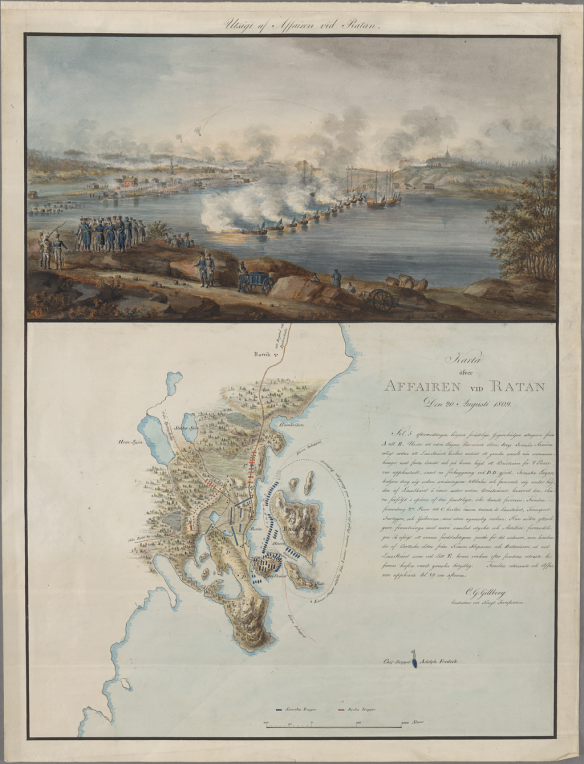The last battle on Swedish soil, which took place on 19–20 August 1809. Having conquered Finland from Sweden, the Russians had a small force in the northern parts of what is now Sweden. The Swedes sought to eliminate this through a combined assault from land and sea, but the Russians moved more rapidly, defeating the Swedish force landed at Ratan at Sävar on 19 August. The next day, the Swedish force was attacked when evacuating from Ratan but the artillery fire from Swedish warships shown in the illustration kept the Russians at bay. Peace followed soon after.
As the Swedish army in Finland found itself defeated, it left the country and retreated back to northern Sweden. The Russians soon followed in due course and large parts of the country came under Russian occupation. The operations at Sävar and Ratan, where the coastal fleet would be involved, were only sporadic Swedish attempts to delay the war and try to reconquer occupied parts of Sweden. The ultimate goal was to liberate the town of Umeå, by surrounding general Kamenski who had the town under occupation with his Russian army. Swedish general Wrede was just south of Umeå, and when his landing of 7.500 troops under Wachtmeister north of Umeå, the surrounding of the city would be complete. This daring operation was to be executed in a joint army-navy operation and all this was agreed upon at a war meeting at Härnösand August 5 1809, where such big names like Döbeln and Sandels participated. The king, Karl XIII as Gustav IV King Adolf had been gotten rid of by a formidable military coup, told Wachtmeister, “The expedition must not be lost, if so Sweden is lost.”
Under Admiral Puke a navy of two ships of the line (Kung Adolph Fredric and Försigtigheten), one frigate (Jarramas) as well as 52 smaller vessels of various types set out for the operations behind enemy lines. The smaller ships were towed by the larger frigate and ships of the line, to increase the speed, to allow the Swedish to get to the point of landing as fast as possible.
Admiral Johan af Puke was an able admiral and war hero (although his name may not sound that thrilling in English). As mentioned above, he had been the commander of “Dristigheten”, the first ship that broke the Russian line at Viborg in 1790. He was therefore a renowned leader when he took command of the expedition to northern Sweden in 1809.
On August 17 1809, the forces arrived at Ratan, outside Umeå, where a thick fog effectively covered the attackers. The landing of the troops went as according to plan and the next day, the land troops started the march upon Sävar. On the night between the 17th and 18th Swedish captain Nordenskiöld led an attack against Umeå itself with his nine gunsloops. He shelled the bridge over the Umeå river but was not able to destroy it as he was met by hard Russian artillery fire. Wachtmeister did not do a thing to assist him, although the explosions were heard to Sävar, and so Nordenskiöld returned out to sea after his failed mission. On the morning of the 19th the troops were attacked by 6.000 Russians in Sävar where they were commanded by Wachtmeister. The land troops here lost one of the bloodiest battles of the war, to the Russian general Kamenski. Wachtmeister showed just exactly how bad a military commander he was.
Wachtmeister retreated back to Ratan with his tails between his legs after having lost at Sävar and at Ratan he was protected by the guns of the navy as well as artillery that was mounted on a nearby island as well as on the beaches. Kamenski followed and in the afternoon on August 20, he attacked without thinking twice. The Russian troops advanced without fear upon the Swedes. The Swedish guns immediately opened fire; death rained down on the Russians from the guns of the Swedish navy as well as from the land artillery, they cut deep, bleeding holes in the Russian lines. Kamenski lost about 3.200 in dead and wounded in this daring but foolish attack. “The village of Ratan was razed to the ground and the treetops were cut all the way to Djäkneboda”, Allan Sandström tells us in his book “Sveriges sista krig”. After these heavy fighting, Kamenski and Wachtmeister met for negotiations. The Russian commander demanded that the Swedes should ship out immediately, which the weak Wachtmeister agreed upon. Wachtmeister promised to ship out, and on August 22, the Swedes left.
If so my position was very critical, I shall do everything in my power to bring my troops therefrom. Although I must agree upon the fact that it was very sad to retreat from a victory like this, which we had won in the last two days, in which I not only did beat the enemy and chased him out to his boats, but also personally placed him upon these boats, so to speak”, Kamenski reported to the Czar. And with these words ended Sweden’s last war.
